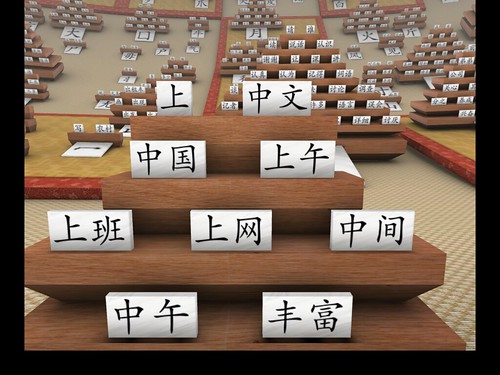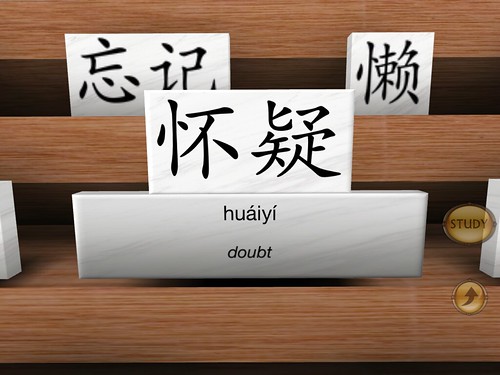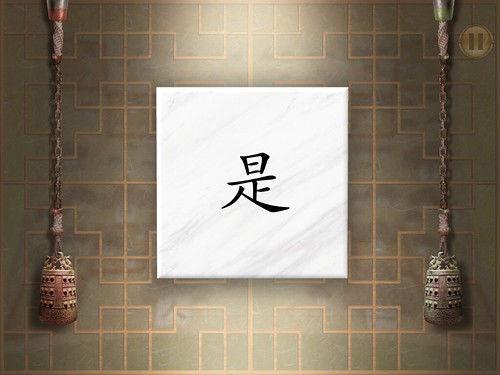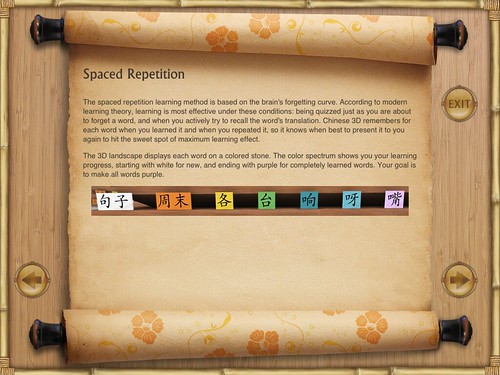Learn Chinese in 3D takes Chinese learning to the third dimension!
What does it mean to take Chinese learning to the third dimension? Well, it means a cool 3D interface for exploring Chinese characters and words, but beyond that, it’s not totally clear. But that’s OK! The way I view this new app, 3D Chinese, is a sort of experiment, a Chinese learning app that was created because it was possible. And I think that’s a good thing. It’s fun, for one (unless you’re a luddite). I’d like to see more of this kind of thing.
Check out the video and some screenshots:
I was a tester for this app, and I thoroughly enjoyed it. I gave the developer a few suggestions, and he was quite responsive to feedback. The style of the app still feels a little too Japanese to me, but it’s still a very polished experience.
So what is the app? Basically, it’s an alternative to a character dictionary or character book, where you have a bunch of common characters laid out in lists by radical. Instead, characters are grouped spatially by radical. You can explore the characters in the 3D environment, learn words containing those characters, etc. It’s a very visual, exploratory way to experience Chinese, and I know that appeals to a lot of people.
The app also has its own built-in SRS functionality. I didn’t test this functionality much, as the app seemed much more suited to a visual tour than the old “doing reps” SRS chore, but this feature might appeal to some.
3D Chinese is currently priced at $2.99. This is a reasonable price for its beautiful 3D visual experience, but this app is not for either (1) the super hardcore learner who wants extreme depth (that user really just wants a dictionary, not something visual-oriented), or (2) a super casual learner who just wants to be entertained by visuals and doesn’t really want to learn (the 3D effects of the app will lose their charm pretty quickly if the learner isn’t actually into the characters at all). If you don’t fall into either of those categories, and don’t find a price of $2.99 exorbitant, I recommend you give this little experiment in visual learning a whirl.







Seems fair.. I’m in the casual learner category right now I have to be honest.. I do want to learn but stumbling every time I try.. so I’ve resorted to playing learning games that make me want to play the game instead of the learning.. but as a result, end up learning.
John, I think this is a fantastic idea. What did the developer use to create this? Unity?
How can I get in touch with them? I just bought it. It is excellent !
Somewhat offtopic: John, have you seen the (relatively new) stackexchange site for learning Chinese?
http://chinese.stackexchange.com/
The stackexchange sites have a really good format for QA, and I personally find them fun.
The style of the app still feels a little too Japanese to me, but it’s still a very polished experience.
This comment really intrigued me because looking at the screenshots, I can’t quite figure out what you mean. Visuals? Interface? Use case assumptions? Choice of vocabulary? From the other direction, what sorts of changes would need to be made to make it “more Chinese”? I’d love to hear more on this topic if you wouldn’t mind expanding on it a bit.
I agree with John, overall ambience seems more Japanese to me too. Beautiful app, visually very appealing.
Why would someone who”doesnt want to learn” dare to use a character memorizing app? And how can you imagine a language learner who “just wants a dictionary, not something visual oriented” to exist?
Therefore your below critic is pointless, sorry.
Quote:
“but this app is not for either (1) the super hardcore learner who wants extreme depth (that user really just wants a dictionary, not something visual-oriented), or (2) a super casual learner who just wants to be entertained by visuals and doesn’t really want to learn “